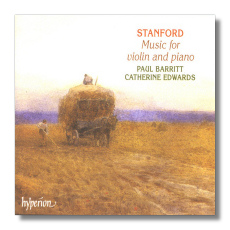
The Internet's Premier Classical Music Source
Related Links
- Stanford Reviews
- Latest Reviews
- More Reviews
-
By Composer
-
Collections
DVD & Blu-ray
Books
Concert Reviews
Articles/Interviews
Software
Audio
Search Amazon
Recommended Links
Site News
 CD Review
CD Review
Charles Villiers Stanford

Music for Violin and Piano
- Violin Sonata #1 in D Major, Op. 11
- Violin Sonata #2 in A Major, Op. 70
- Caoine (A Lament), Op. 54/1
- 5 Characteristic Pieces, Op. 93
Paul Barritt, violin
Catherine Edwards, piano
Hyperion CDA67024 77:54
Summary for the Busy Executive: Who knew Stanford was this good?
If nothing else, Stanford has won eternal glory as one of the forgers of twentieth-century British music. The pupils who came under his tutelage include Vaughan Williams, Holst, Howells, Ireland, Bridge, Butterworth, Moeran, Bliss, and Grainger. A notoriously abrasive personality and a bit of a bully, Stanford nevertheless saw to it that his students knew their stuff. Contrary to contemporary pedagogy which emphasized "paperwork" to the exclusion of everything else, he insisted that they be able to hear their scores performed. As a result, they came away with solid technique. In the minds of the public, the students have overtaken the master. It didn't help that he feuded with Elgar and attracted George Bernard Shaw's skeptical ear. He has come down to us as a great pedagogue and a great pedant.
This is unfair. Stanford has his nothing-much pieces, but he has his poetic ones as well. He excelled in chamber music, and indeed chamber music held a lifelong fascination for him, as both composer and performer. The first violin sonata's low opus number obviously marks it as an early work. Stanford had just returned to England after study in Germany, and this piece shows us more than he learned a lot. The first movement, a sonata, proceeds as swiftly and as inevitably as Beethoven. Stanford may not have been a great composer, but he certainly thought like one. There's an easy mastery on display, a swift, direct approach to complex argument. The sonata shows an impressive unity. An impressively small set of ideas, gestures, and themes, appears in all three movements. An arresting octave leap that opens the sonata also begins the main theme of the finale. On the other hand, the finale varies the theme of the slow movement, itself a variation form. The slow movement structure is, again, variation, but the argument proceeds more as a Schumannesque or Brahmsian fantasy, while the third movement flies with the energy of Mendelssohn.
"Caoine" (pronounced "keen") is part of a larger set of Irish Fantasies, Op. 54. For those who know actual Irish folk music, this little piece sounds as Liszt-Hungarian as Celtic. On the other hand, its full of parlor-ballad "Irish" tropes, notably a harp-like accompaniment in the piano. Apart from all that, however, Stanford constructs a beautiful, long line of melody that lifts this little piece above the common of its genre.
A "character" or "characteristic" piece slides in and around several attempts to define it. Beethoven described his first Leonore overture as a "characteristic overture," by which he probably meant it was characteristic of opera overtures. Sometimes "characteristic" meant "characteristic of the composer's style." Mendelssohn's characteristic pieces tend to characterize single moods. Schumann's characterize both moods and characters. Stanford's 5 Characteristic Pieces tend to follow Schumann and, I must say, with as much formal resource. The rhythmic invention, particularly in the movements "In a Gondola" and "Arabesques" where the beat seems to constantly shift, is astonishing. Jeremy Dibble's superior liner notes point out many structural felicities, all of which indicate Stanford's habits of symphonic thinking, even in small forms. The workmanship and the melodic invention are exquisite.
Stanford's first violin sonata, though finely-written, was old-fashioned even in its day. The second is conservative, but still of its time. Here, Stanford has absorbed Brahms and has produced a violin sonata that one can compare to those of Brahms without having to roll one's eyes or make allowances. I suspect most people in a blind test wouldn't be surprised to learn Brahms wrote it, it's that good. The first movement, a fresh and lyrical sonata, nevertheless has a good bit of structural steel in it. Stanford builds it from two motives: a rising quasi-arpeggio and a rising scale through the third, major or minor (A B C# or A B C). Stanford reserves the minor version for the second subject group. The slow movement, a variation set, also begins with that rising scale fragment (A B C#), this time not on the tonic, but on the mediant. So instead of D Major, we have F Sharp-minor. The scherzo varies this idea. Essentially, instead of A B C, we have A Bb C. All this shows that Stanford characteristically thinks in terms of entire pieces, rather than in separate movements, just as Beethoven, past a certain point, did. The finale lies outside the rest of the sonata in that regard, but it's still a marvelous piece. A sonata-rondo, it alternates a restless first theme with a noble second, and the music soars.
Barritt and Edwards play elegantly. It's a delight to hear them create the most persuasive Stanford performances I've ever heard. This CD may well end up on my best-of-year list.
Copyright © 2009, Steve Schwartz


















